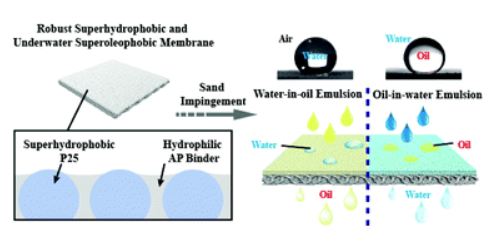Abstract
Superhydrophobic and underwater superoleophobic surface combine the superiorities of the two opposite wettabilities. Generally, such a surface is constructed by hydrophilic areas and hydrophobic areas treated with fluorine-containing modifiers. However, the surface energy in a narrow range and poor bonding force between water-loving and water-repelling components make the surface fragile and its wettability unstable. Herein, we present a strategy to fabricate a robust surface with superhydrophobicity and underwater superoleophobicity. Hydrophilic aluminum phosphate as a binder can strongly interact with superhydrophobic titanium dioxide nanoparticles. Mixing the two ingredients to accurately control the surface energy in a narrow range and then spray coating, the superhydrophobic and underwater superoleophobic surfaces are conveniently prepared on diverse substrates. Under acid/base aqueous solution conditions, O-2-plasma etching, and sand impingement, the coatings remain superhydrophobic and underwater superoleophobic. Taking advantage of the wettability and robustness of coatings, the as-prepared membranes realize on-demand and multicycle separation under gravity without continuous external stimulus. Importantly, even after 100 sand impingement cycles, the treated membranes still maintain prominent separation performance.

Keywords Plus:IN-OIL EMULSIONSPVDF MEMBRANESFABRICATION
Published in NANOSCALE,Volume 13;10.1039/d1nr04658f,SEP 28 2021


